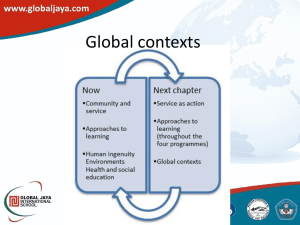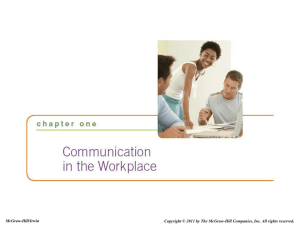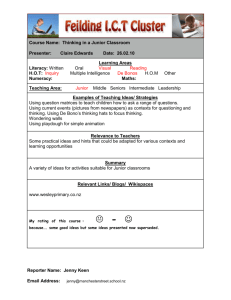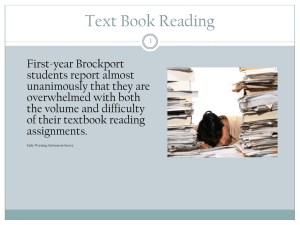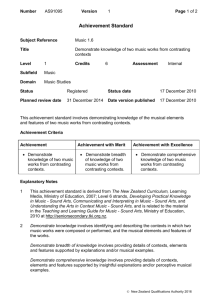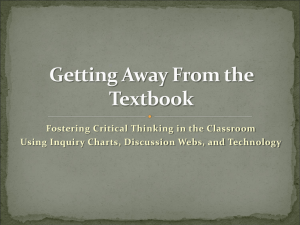File - Life isn`t about finding yourself... it`s about creating
advertisement
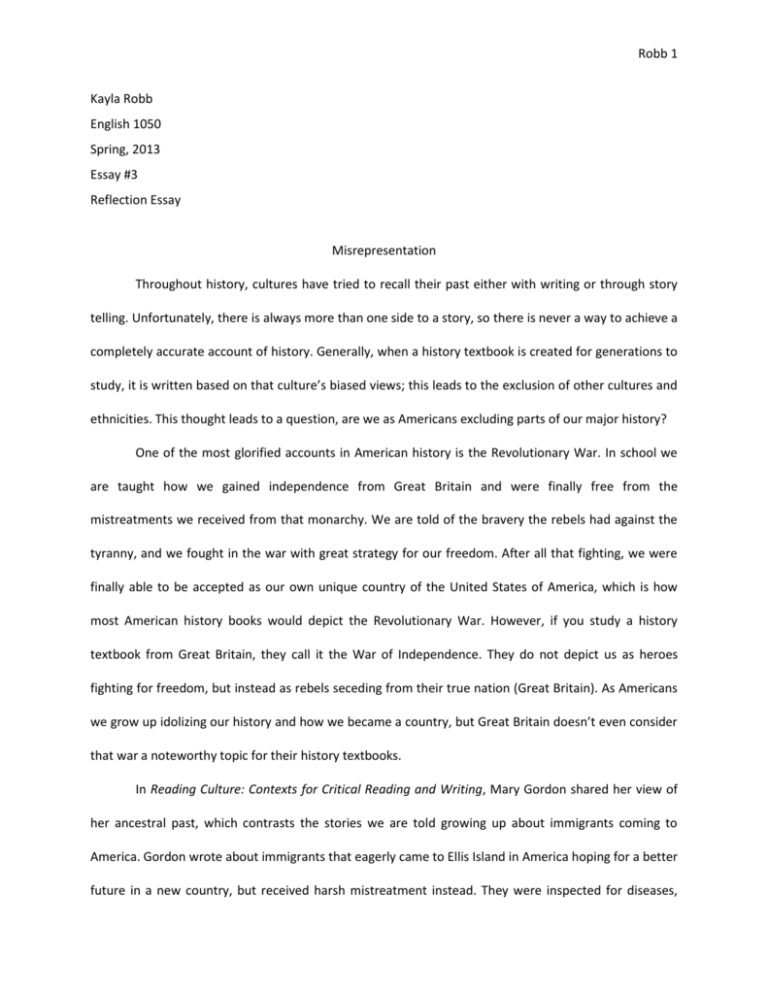
Robb 1 Kayla Robb English 1050 Spring, 2013 Essay #3 Reflection Essay Misrepresentation Throughout history, cultures have tried to recall their past either with writing or through story telling. Unfortunately, there is always more than one side to a story, so there is never a way to achieve a completely accurate account of history. Generally, when a history textbook is created for generations to study, it is written based on that culture’s biased views; this leads to the exclusion of other cultures and ethnicities. This thought leads to a question, are we as Americans excluding parts of our major history? One of the most glorified accounts in American history is the Revolutionary War. In school we are taught how we gained independence from Great Britain and were finally free from the mistreatments we received from that monarchy. We are told of the bravery the rebels had against the tyranny, and we fought in the war with great strategy for our freedom. After all that fighting, we were finally able to be accepted as our own unique country of the United States of America, which is how most American history books would depict the Revolutionary War. However, if you study a history textbook from Great Britain, they call it the War of Independence. They do not depict us as heroes fighting for freedom, but instead as rebels seceding from their true nation (Great Britain). As Americans we grow up idolizing our history and how we became a country, but Great Britain doesn’t even consider that war a noteworthy topic for their history textbooks. In Reading Culture: Contexts for Critical Reading and Writing, Mary Gordon shared her view of her ancestral past, which contrasts the stories we are told growing up about immigrants coming to America. Gordon wrote about immigrants that eagerly came to Ellis Island in America hoping for a better future in a new country, but received harsh mistreatment instead. They were inspected for diseases, Robb 2 tested for IQ and reading abilities, and marked with chalk if they had any problems. “Mothers feared that if their children cried too much, their red eyes would be mistaken for a symptom of [trachoma] and the whole family would be sent home” (434). As much as Americans like to imagine the immigration process as being a rewarding experience for their ancestors, it was a brutal experience that is not accurately portrayed in history books. Many schools try to ignore the dark times of our country’s past, but it is something that needs to be taught so the ethnicities that were mistreated can be represented fairly in American history. In 2008, the first ever black president was elected into office. Before he was elected, Barack Obama gave a speech titled “A More Perfect Union” during his presidential campaign that highlighted African-Americans and how their history changed America (476). The horrible stories of slavery have been passed down to each generation, and also in the history textbooks in schools. However, most history books do not give a fair representation to how the slaves were treated, so this has created anger toward the mistreatment of other races as well as the act of slavery. White and black Americans alike feel resentment toward each other because of the past. “… this too widens the racial divide, and blocks the path to understanding. This is where we are right now. It’s a racial stalemate we’ve been stuck in for years” (480). Even today, almost 150 years after the Thirteenth Amendment of the US Constitution was ratified (officially abolishing slavery), some black Americans feel misrepresented in history for the abuse their ancestors went through. Not only are cultures being under-represented in history textbooks, but also in our current society. Children grow up learning how to treat others from their parents, and that is largely based on society’s views. One such example is how some Americans view minorities negatively because they cannot speak English well (or at all). With these false assumptions from current citizens, immigrants who came to America are being treated unfairly and told they need to speak “American.” That statement is completely unfair since our country is full of different races, cultures, and languages; there is no Robb 3 “American language.” In Reading Culture: Contexts for Critical Reading and Writing, Gloria Anzaldúa was victim to such assumptions. She wrote about how her experience in school as a child was awful because she was forced to create her own language. Since she wasn’t allowed to speak Spanish, and her accent was frowned upon, she decided to almost create her own language. Most students today who are bilingual with Spanish and English seem to form a language that is a mixture of the two so they can satisfy both cultures; home and school life. “… what resource is left to them but to create their own language? A language that can connect their identity to…” (522). Without being taught that diversity is positive and learning more than one language is a talent, Americans often discriminate against English language learners. As a child, Anzaldúa was physically punished if she spoke her native language. “I remember being caught speaking Spanish at recess – that was good for three licks on the knuckles with a sharp ruler” (521). That message that came from educators told her that the culture she identified with was wrong, and sadly this ideology is still practiced today because of the lack of education on other cultures. Being ignorant of different cultures and their languages is an example of learned biased opinions. In comparison to textbooks portraying history (such as the immigrants coming to America on Ellis Island), learned biased opinions is something people observe from their authority figures such as parents or educators. Another example of learned biased opinions is history being told through story telling. A culture that is known to do this is the Native Americans. In Reading Culture: Contexts for Critical Reading and Writing, Jane Tompkins pieced together essays from different people’s perspectives on the Native American history and culture. She realized that not all the essays she studied could be reliable because they were biased from the author who wrote it. “As I read on, however, I discovered that the problem was more complicated than deciding whose version of events was correct” (441). Sadly, there is never a way to know the true history unless you’ve experienced it yourself; and even then, you can’t tell it to other people without being biased! “Being aware that all facts are motivated, Robb 4 believing that people are always operating inside some particular interpretive framework or other is a pertinent argument when what is under discussion is the way beliefs are grounded” (450). Compared to history being inappropriately portrayed in textbooks or learned biased opinions being passed down to generations, there are the current events happening today that don’t get the attention they need. These events are what we will remember in the future; therefore they should be accurately documented as they happen. However, current events do not always get documented or advertised correctly. One such incident is slum tourism. Slum tourism started around the 1800s when the upper class in London wanted to see the condition of eastern London. Kennedy Odede wrote, “I was 16 when I first saw a slum tour. I was outside my 100-square-foot house washing dishes, looking at the utensils with longing because I hadn’t eaten in two days. Suddenly a white woman was taking my picture. I felt like a tiger in a cage. Before I could say anything, she had moved on” (519). This horrific act of slum tourism has been going on since the 1800s, and still happens today. The rich will scrutinize the poor for their own enjoyment, while the poor being observed gain nothing but shame from the experience. Unfortunately this affair (and many others) doesn’t get documented accurately, so this is why we are not taught about it in history; therefore, those affected by them do not get represented fairly. Ultimately, the best way to accurately know where you come from is to research the past of your ancestors. In Reading Culture: Contexts for Critical Reading and Writing, Jamaica Kincaid writes with a narration from Annie John and reflects on her ancestors and how they were victims to slavery. She explains: But we, the descendents of the slaves, knew quite well what had really happened, and I was sure that if the tables had turned and we would have acted differently; I was sure that if our ancestors had gone from Africa to Europe and come upon the people living there, they would Robb 5 have taken proper interest in the Europeans on first seeing them, and said, “How nice,” and then gone home to tell their friends about it. (500) Kincaid (narrated by John) made a very strong point about the possibility of her culture meeting the Europeans first and how that small change would affect the entire future. She then compared her ancestors past to the history portrayed in the textbooks at her school. Unfortunately, the textbooks did not do an accurate job of depicting her past relatives’ struggles. After hearing the stories of her past, she realized that the textbooks were not accurate; which in turn made her angry and hate Christopher Columbus. “… to see the triumphant Columbus, brought so low, seated at the bottom of a boat just watching things go by” (500). She then wrote in her textbook in pen to defy the picture. By defacing her textbook, she was taking a stand against the unheard voices of her ancestors that did not get a mention in the textbooks. There will never be a completely accurate way to represent the past because it will be humans who will recall the events. Every person is biased and they will recall their past differently than someone else. The greatest way to know the past is to research multiple views, just like Jane Tompkins did when she wanted a correct account of the Native Americans. Ultimately, the best way to know the past is to research with an open mind and try to be unbiased. Robb 6 Works Cited Anzaldúa, Gloria. “How to Tame a Wild Tongue.” Reading Culture: Contexts for Critical Reading and Writing. Eighth Edition. Diana George and John Trimbur. New Jersey: Pearson, 2012. 521-529. Print. Gordon, Mary. “More than just a Shrine: Paying Homage to the Ghosts of Ellis Island.” Reading Culture: Contexts for Critical Reading and Writing. Eighth Edition. Diana George and John Trimbur. New Jersey: Pearson, 2012. 431-435. Print. Kincaid, Jamaica. "Columbus in Chains."Reading Culture: Contexts for Critical Reading and Writing. Eighth Edition. New Jersey: Pearson, 2012. 498-503. Print. Obama, Barack. “A More Perfect Union.” Reading Culture: Contexts for Critical Reading and Writing. Eighth Edition. Diana George and John Trimbur. New Jersey: Pearson, 2012. 476-483. Print. Odede, Kennedy. "Slumdog Tourism."Reading Culture: Contexts for Critical Reading and Writing. Eighth Edition. New Jersey: Pearson, 2012. 518-520. Print. Tompkins, Jane. "’Indians’: Textualism, Morality, and the Problem of History."Reading Culture: Contexts for Critical Reading and Writing. Eighth Edition. New Jersey: Pearson, 2012. 439-451. Print.
